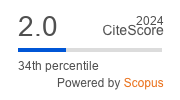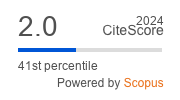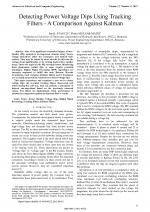| 4/2012 - 12 |
Detecting Power Voltage Dips using Tracking Filters - A Comparison against KalmanSTANCIU, I.-R. |
| Extra paper information in |
| Click to see author's profile in |
| Download PDF |
Author keywords
power quality, voltage dips, digital signal processing, tracking filters, kalman filters
References keywords
power(21), voltage(10), measurement(10), quality(9), kalman(8), system(7), instrumentation(6), analysis(6), filter(5), systems(4)
Blue keywords are present in both the references section and the paper title.
About this article
Date of Publication: 2012-11-30
Volume 12, Issue 4, Year 2012, On page(s): 77 - 82
ISSN: 1582-7445, e-ISSN: 1844-7600
Digital Object Identifier: 10.4316/AECE.2012.04012
Web of Science Accession Number: 000312128400012
SCOPUS ID: 84872821331
Abstract
Due of its significant economical impact, Power-Quality (PQ) analysis is an important domain today. Severe voltage distortions affect the consumers and disturb their activity. They may be caused by short circuits (in this case the voltage drops significantly) or by varying loads (with a smaller drop). These two types are the PQ currently issues. Monitoring these phenomena (called dips or sags) require powerful techniques. Digital Signal Processing (DSP) algorithms are currently employed to fulfill this task. Discrete Wavelet Transforms, (and variants), Kalman filters, and S-Transform are currently proposed by researchers to detect voltage dips. This paper introduces and examines a new tool to detect voltage dips: the so-called tracking filters. Discovered and tested during the cold war, they can estimate a parameter of interest one-step-ahead based on the previously observed values. Two filters are implemented. Their performance is assessed by comparison against the Kalman filters results. |
| References | | | Cited By «-- Click to see who has cited this paper |
| [1] M. H. J. Bollen, Understanding Power Quality Problems. Voltage Sags and Interruptions. NY: IEEE Press, New York, 2000.
[2] D. Gallo, C. Landi, M. Luiso, "Accuracy Analysis of Algorithms Adopted in Voltage Dip Measurements", IEEE Trans. on Instrumentation and Measurement, Vol. 59, No. 10, pp. 2652-2659, Oct. 2010. [CrossRef] [Web of Science Times Cited 67] [SCOPUS Times Cited 53] [3] J. Barros, E. Perez, "Automatic Detection and Analysis of Voltage Events in power Systems", IEEE Transactions on Instrumentation and Measurement, Vol. 55, No. 5, pp. 1487-1493, Sept. 2006. [CrossRef] [Web of Science Times Cited 60] [SCOPUS Times Cited 74] [4] EN 50160:2007, Voltage Characteristics of Electricity Supplied by Public Distribution Networks [5] Electromagnetic Compatibility (EMC) Part 4-30: Testing and Measurement Techniques-Power Quality Measurement Methods, IEC 61000-4-30, 2003. [6] M. Didden, E. De Jaeger, W. D'Haeseleer, R. Belmans, "How to connect a voltage sag-measuring device: Phase to phase or phase to neutral?", IEEE Trans. on Power Delivery, vol. 20, no. 2, pp. 1174-1181, Apr. 2005. [CrossRef] [Web of Science Times Cited 13] [SCOPUS Times Cited 13] [7] R. C. Leborgne, G. Olguin, M. H. J. Bollen, "The Influence of PQ-Monitor Connection on Voltage Dip Measurements", Proceedings of IEE MedPower Conference, Nov. 2004, Cyprus. [8] P. K. Dash, R. K. Jena, G. Panda, A. Routray, "An Extended Complex Kalman Filter for Frequency Measurement of Distorted Signals", IEEE Trans. on Instrumentation and Measurement, Vol. 49, No. 4, pp. 746-753, Aug. 2000. [CrossRef] [Web of Science Times Cited 114] [SCOPUS Times Cited 166] [9] P. K. Dash, M. V. Chilukuri, "Hybrid S-Transform and Kalman Filtering Approach for Detection and Measurement of Short Duration Disturbances in Power Networks", IEEE Trans. on Instrumentation and Measurement, Vol. 53, No. 2, pp. 588-596, Apr. 2004. [CrossRef] [Web of Science Times Cited 88] [SCOPUS Times Cited 112] [10] I. Y. Gu, E. Styvaktakis, "Bridge the gap: Signal processing for power quality applications", Electric Power System Research, vol. 66, no. 1, pp. 83-96, Jul. 2003. [CrossRef] [Web of Science Times Cited 56] [SCOPUS Times Cited 72] [11] E. Perez, J. Barros, "An extended Kalman filtering approach for detection and analysis of voltage dips in power systems", Electric Power Systems Research, vol. 78, pp. 618-625, Apr. 2008. [CrossRef] [Web of Science Times Cited 26] [SCOPUS Times Cited 40] [12] E. Perez, J. Barros, "Application of advanced digital signal processing tools for analysis of voltage events in power systems", International Journal of Electrical Engineering Education, Vol. 46, No. 3, pp. 211-224, Jul. 2009. [13] E. Styvaktalcis, I. Y. Gu, M. H. J. Bollen, "Voltage Dip Detection and Power System Transients", Power Engineering Society Summer Meeting, Vancouver, Canada, 15-19 Jul. 2001, pp. 683-688. [CrossRef] [14] A. A. Abdelsalam, A. A. Eldesouky, A. A. Sallam, "Characterization of power quality disturbances using hybrid technique of linear Kalman filter and fuzzy-expert system", Electric Power System Research, vol. 83, pp. 41-50, Feb. 2011. [CrossRef] [Web of Science Times Cited 80] [SCOPUS Times Cited 105] [15] J. B. V. Reddy, P. K. Dash, R. Samantaray, A.K. Moharana, "Fast Tracking of Power Quality Disturbance Signals Using an Optimized Unscented Filter", IEEE Transactions on Instrumentation and Measurement, Vol. 58, No. 12, pp. 3943-3952, Dec. 2009. [CrossRef] [Web of Science Times Cited 51] [SCOPUS Times Cited 70] [16] S. Santoso, E. J. Powers W. M. Grady, P. Hofman, "Power quality assessment via wavelets transform analysis," IEEE Trans. on Power Delivery, Vol. 11, No. 2, pp. 924-930, Apr. 1996. [CrossRef] [Web of Science Times Cited 571] [SCOPUS Times Cited 831] [17] G. Guerrieri, A. Moschitta, P. Carbone, C. Muscas, "Statistical Properties of Voltage Dip Detectors", IEEE Trans. on Instrumentation and Measurement, Vol. 59, No. 11, pp. 2800-2807, Jul. 2010. [CrossRef] [Web of Science Times Cited 1] [SCOPUS Times Cited 3] [18] R. A. Flores, "State of the art in the classification of power quality events, an overview" , in Proc. 10th International Conference Harmonics Quality of Power, vol. 1, pp. 17-20, 2002. [CrossRef] [SCOPUS Times Cited 46] [19] W. R. A. Ibrahim, M. M. Morcos, "Artificial intelligence and advanced mathematical tools for power quality applications: A survey", IEEE Trans. on Power Delivery, vol. 17, no. 2, pp. 668-673, Apr. 2002. [CrossRef] [SCOPUS Times Cited 230] [20] J. Sklansky, Optimizing the dynamic parameter of a track-while-scan system, RCA Laboratories, Princeton, NJ, June 1957. [21] P. R. Kalata, K. M. Murphy, "?-ß target tracking with track rate variations", in Proceedings of 29th Southeastern Symposium on System Theory, 1997, pp. 70-74. [CrossRef] [Web of Science Times Cited 13] [22] D. Tenne, T. Singh, "Optimal design of ?-ß-(?) filters", in Proceedings of American Control Conference, Chicago, Illinois, 2000, vol. 6, pp. 4348-4352. [CrossRef] [SCOPUS Times Cited 31] [23] P. I. Corke, M. C. Good, "Dynamic effects in high-performance visual servoing", in International Conference on Robotics and Automation, Nice, France, 1992, pp. 1838-1843. [CrossRef] [Web of Science Times Cited 30] [24] R. Stanciu, P. Y. Oh, "Human-in-the-loop Camera Control for a Mechatronic Broadcast Boom", IEEE/ASME Transactions on Mechatronics, Vol. 12, Issue 1, pp. 41 - 52, Feb. 2007. [CrossRef] [Web of Science Times Cited 11] [SCOPUS Times Cited 11] [25] C. L. Phillips, H. T. Nagle, Digital Control System Analysis and Design, Third Edition, Prentice Hall, 1995. [26] R. E. Kalman, "A New Approach to Linear Filtering and Prediction Problems", Transaction of the ASME - Journal of Basic Engineering, pp. 35-45, 1960. [27] L. Matthies, T. Kanade, "Kalman Filter-based Algorithms for Estimating Depth from Image Sequences", International Journal of Computer Vision, vol. 3, pp. 209-236, Sep. 1989. [CrossRef] [Web of Science Times Cited 350] [SCOPUS Times Cited 477] [28] H. Mohamed, K. P. Schwarz, "Adaptive Kalman Filtering for INS/GPS", Journal of Geodesy, vol. 73, no. 4, pp. 193-203, 1999. [CrossRef] [Web of Science Times Cited 796] [SCOPUS Times Cited 1019] [29] G. Welch, G. Bishop, An Introduction to the Kalman Filter, SIGGRAPH Chapel Hill, 2000. Web of Science® Citations for all references: 2,327 TCR SCOPUS® Citations for all references: 3,353 TCR Web of Science® Average Citations per reference: 78 ACR SCOPUS® Average Citations per reference: 112 ACR TCR = Total Citations for References / ACR = Average Citations per Reference We introduced in 2010 - for the first time in scientific publishing, the term "References Weight", as a quantitative indication of the quality ... Read more Citations for references updated on 2025-05-25 21:10 in 137 seconds. Note1: Web of Science® is a registered trademark of Clarivate Analytics. Note2: SCOPUS® is a registered trademark of Elsevier B.V. Disclaimer: All queries to the respective databases were made by using the DOI record of every reference (where available). Due to technical problems beyond our control, the information is not always accurate. Please use the CrossRef link to visit the respective publisher site. |
Faculty of Electrical Engineering and Computer Science
Stefan cel Mare University of Suceava, Romania
All rights reserved: Advances in Electrical and Computer Engineering is a registered trademark of the Stefan cel Mare University of Suceava. No part of this publication may be reproduced, stored in a retrieval system, photocopied, recorded or archived, without the written permission from the Editor. When authors submit their papers for publication, they agree that the copyright for their article be transferred to the Faculty of Electrical Engineering and Computer Science, Stefan cel Mare University of Suceava, Romania, if and only if the articles are accepted for publication. The copyright covers the exclusive rights to reproduce and distribute the article, including reprints and translations.
Permission for other use: The copyright owner's consent does not extend to copying for general distribution, for promotion, for creating new works, or for resale. Specific written permission must be obtained from the Editor for such copying. Direct linking to files hosted on this website is strictly prohibited.
Disclaimer: Whilst every effort is made by the publishers and editorial board to see that no inaccurate or misleading data, opinions or statements appear in this journal, they wish to make it clear that all information and opinions formulated in the articles, as well as linguistic accuracy, are the sole responsibility of the author.



